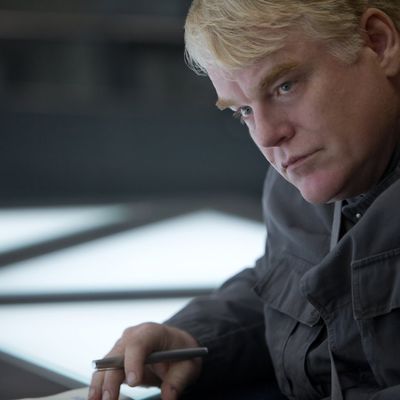
It’s another edition of the Monday Morning Movie Club, and we’re here to talk about latest installment of The Hunger Games franchise, Mockingjay — Part 1. So many spoilers are ahead.
Did they end it in the right place? (Almost, but no.)
When it was announced that they were going to split Mockingjay into two movies, people started wondering where the filmmakers would end Part 1. So, how did they do? They almost nailed it. Since the movie was so focused on reuniting Katniss and Peeta, it makes sense for his rescue to be the movie’s big finish. The problem is, the movie should’ve ended after the scene in which they reunite — you know, that scene in which Peeta, out of nowhere, violently jumps on Katniss and nearly strangles her to death, before being knocked unconscious. When I first saw the movie, after it cut to black there, I audibly gasped and said, excitedly, “Is that really where they’re going to end it?” As we all know, it wasn’t. The movie had about five more minutes, which included Katniss learning why Peeta did that. And that sucks. For people who haven’t read the books, how about some mystery that will make us foam at the mouth, waiting for the conclusion? (Director Francis Lawrence addresses this possibility, which was considered, in this BuzzFeed article, calling it “the Breaking Bad ending.”) Instead, what do we have to wait for now? To see if Haymitch gets to drink again?
Yes, that would have been a dark ending. But this is a dark movie. Ride it out. Go big or go home (hungry for darkness). As the transition from the Hunger Games–focused first part of the franchise to a full-on tale of war and rebellion, Mockingjay – Part 1 is kind of like the franchise’s Empire Strikes Back. (This is a very very common parallel to use when it comes to genre franchises.) And why is Empire generally considered the best of the Star Wars movies? Part of it has to do with its dark-as-hell ending. Peeta strangling Katniss could’ve been like Luke getting his hand cut off. —Jesse David Fox
Did they finally figure out how to prevent Peeta from messing up all the time?
With no actual Hunger Games in this film, Peeta had far fewer opportunities to mess up (as he did over and over in Catching Fire). Still, that exchange where Julianne Moore’s President Coin suggested to Philip Seymour Hoffman’s Plutarch Heavensbee, “Maybe you should have rescued the boy instead,” and Plutarch scoffed, “No” … well, he was just saying what we’ve all been thinking. —Kyle Buchanan
When did Effie become the best?
Although Elizabeth Banks’s Effie Trinket isn’t anywhere to be found in The Hunger Games’ final book, the movie’s writers smartly slotted her into the film in place of Katniss’s Capitol “style team.” That’s perhaps because Elizabeth Banks is wonderful as the fashionista turned rebel. At first, she’s just a rebel by necessity, but when she starts her “work” on Katniss, preparing her for the Mockingjay propos, Effie comes alive again. Even without the familiar gaudy makeup, towering wigs, and even eyebrows, Banks turns Effie into a three-dimensional character whose cheeriness is finally turning into consciousness. —Lindsey Weber
Where Is District 13 Making All These Jumpsuits?
Mockingjay takes place almost entirely in the underground bunker that comprises District 13, and everyone in this bunker wears the same uniform: a drab, unisex olive jumpsuit. Where are all these jumpsuits coming from? They’re clearly not one size fits all; if you look closely, you can notice subtle variations: Julianne Moore’s is military-crisp, Philip Seymour Hoffman’s is comfortable and roomy, Jennifer Lawrence’s is frumpy and formless. (Clearly a tailor is hiding somewhere around those missiles.) It’s all a setup for one of the movie’s best jokes: Effie Trinket showing her allegiance to the cause by turning her jumpsuit into a stylish cape. Who says homogeny can’t be chic? —Nate Jones
It’s been three movies, we get it, the names are weird.
Did you die a little inside every time Julianne Moore had to say “Beetee,” “Panem,” or “Plutarch Heavensbee”? We have finally found something the talented Moore cannot do: convincingly pronounce those ridiculous monikers that Suzanne Collins came up with, which perhaps worked on the page but feel more than a little dorky on the screen. A related complaint: The movie’s insistence that we must know the names of every single character, no matter how minor. The names of Cressida’s crew might matter to a Hunger Games reader, but in the film, those three characters have a sum total of maybe two lines. In a very busy movie filled with tons of characters and subplots to keep track of; not every newbie needs such a thorough introduction. —Kyle Buchanan
Is it time to redo the first Hunger Games?
The last two Hunger Games films have been so gorgeously composed, filled with dramatic long takes and genuinely surprising moments of stillness, that it’s incredible to remember how the first movie was filmed by what looked like a shaky cam strapped to a rock tumbler. Can Francis Lawrence go back and reshoot Gary Ross’s series-starter, please? —Kyle Buchanan

